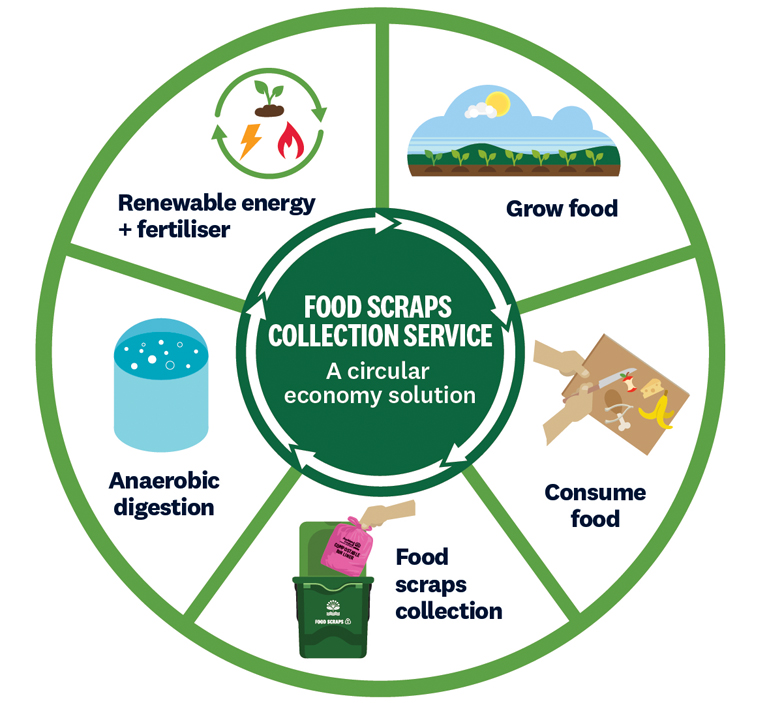Why we want to collect food scraps from households
Food is a valuable resource, however when food goes to landfill it produces methane and CO2 which are harmful greenhouse gases.
One tonne of methane released into the atmosphere creates the same amount of global warming as 25 tonnes of CO2.
When food is trapped in landfill the nutrients it contains are also trapped, but those nutrients could be returned to the land in biofertiliser to grow more food.

The collection of
rukenga kai is one of several approaches we are taking to keep food scraps out of the rubbish. Other initiatives include:
- preventing food waste in the first place
- supporting redistribution of food through food rescue initiatives
- encouraging home and community composting.
For more information, see our Waste Management and Minimisation Plan.
We will collect food scraps separately in Auckland’s roadside collection service. The scraps will then be converted into renewable energy and biofertiliser through an anaerobic digestion facility in Reporoa.
Learn more about
anaerobic digestion.
How you will benefit from the food scraps collection service
The climate and environmental benefits of recycling food scraps are huge, but there’s also a personal benefit in being more aware of your food waste.
Separating your food scraps helps raise awareness of how much food is being wasted, which can lead to better meal planning and save you money.
If you compost or have a worm farm, ka pai te mahi! You can still use your new food scraps bin for items that aren’t usually composted such as meat, small bones, onion skins, shellfish, and dairy.
Learn more about
how to use your food scraps bin.
Food scraps collections are already happening in New Zealand
The government has committed to making food scraps services available to all urban areas in New Zealand by 2030.
Food scraps collections are already happening in other areas of New Zealand including Tauranga, Hamilton and New Plymouth.
Learn more about
Improving household recycling and food scrap collections.
Why recycling food scraps is preferred over using a waste disposal unit
Food scraps are a resource which can be converted into renewable energy and fertiliser through our food scraps collection service.
If you put food scraps into a waste disposal unit, we cannot guarantee they will not end up in a landfill.
The best way to manage food scraps is to put them into a home compost or the Auckland Council food scraps bin.
See
Reduce your food scraps and garden waste.
How we collect food scraps
Our trucks collect your food scraps every week.
Your food scraps collection day is the same day of the week as your council rubbish or recycling service.
Check your council collection day.
Place your food scraps bin roadside for collection the night before your council collection day.
Some of the food scraps collection trucks are electric. As electric vehicle technology becomes more reliable and financially viable, we will increase the number of electric vehicles for collecting food scraps.
Find out
what to do if there's a problem with your food scraps bin or collection.
How the food scraps are processed
Once your food scraps are picked up, they are dropped off at consolidation sites around Auckland. The food scraps are consolidated (or mixed together) and moved into larger trucks for the journey to the processing facility.
The food scraps processing plant is centrally located in the North Island and can process food scraps from other cities and commercial companies. Once fully operational, the plant will process 75,000 tonnes of organic material each year, including food scraps from Auckland and other councils.
The plant uses anaerobic digestion technology – a biological process that breaks down organic material without oxygen.
Food scraps are broken down in closed tanks into:
- biogas (which will be captured and converted into renewable energy)
- nutrient liquid fertiliser (which will be used on farmland).
This is the first time this technology has been used to process food scraps on a large scale in New Zealand.
If any contaminants (such as glass, metal or plastic) are found in the process, the plant has machinery that removes them so that they don’t end up in the liquid fertiliser.
How we monitor the food scraps facility
All facilities that accept food scraps will operate within their consent conditions.
The largest facilities at Papakura and Reporoa are fitted with a purpose engineered odour filtration system to ensure that odour from the buildings does not discharge into the atmosphere above resource consent limits.
